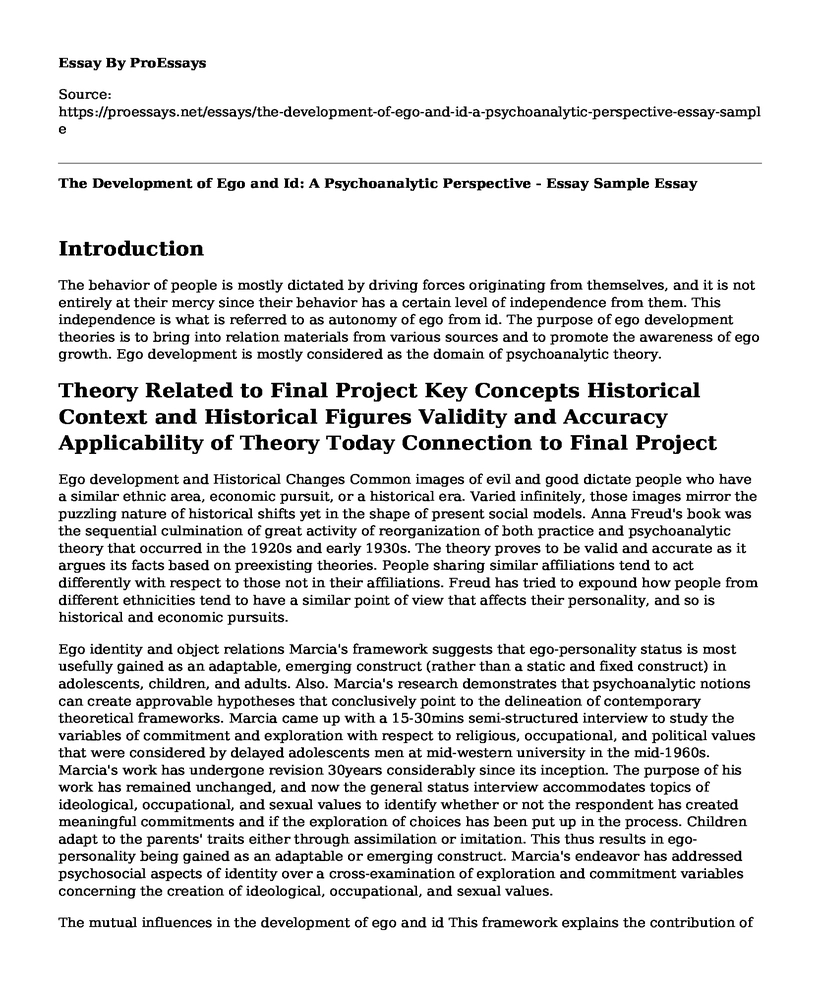Introduction
The behavior of people is mostly dictated by driving forces originating from themselves, and it is not entirely at their mercy since their behavior has a certain level of independence from them. This independence is what is referred to as autonomy of ego from id. The purpose of ego development theories is to bring into relation materials from various sources and to promote the awareness of ego growth. Ego development is mostly considered as the domain of psychoanalytic theory.
Theory Related to Final Project Key Concepts Historical Context and Historical Figures Validity and Accuracy Applicability of Theory Today Connection to Final Project
Ego development and Historical Changes Common images of evil and good dictate people who have a similar ethnic area, economic pursuit, or a historical era. Varied infinitely, those images mirror the puzzling nature of historical shifts yet in the shape of present social models. Anna Freud's book was the sequential culmination of great activity of reorganization of both practice and psychoanalytic theory that occurred in the 1920s and early 1930s. The theory proves to be valid and accurate as it argues its facts based on preexisting theories. People sharing similar affiliations tend to act differently with respect to those not in their affiliations. Freud has tried to expound how people from different ethnicities tend to have a similar point of view that affects their personality, and so is historical and economic pursuits.
Ego identity and object relations Marcia's framework suggests that ego-personality status is most usefully gained as an adaptable, emerging construct (rather than a static and fixed construct) in adolescents, children, and adults. Also. Marcia's research demonstrates that psychoanalytic notions can create approvable hypotheses that conclusively point to the delineation of contemporary theoretical frameworks. Marcia came up with a 15-30mins semi-structured interview to study the variables of commitment and exploration with respect to religious, occupational, and political values that were considered by delayed adolescents men at mid-western university in the mid-1960s. Marcia's work has undergone revision 30years considerably since its inception. The purpose of his work has remained unchanged, and now the general status interview accommodates topics of ideological, occupational, and sexual values to identify whether or not the respondent has created meaningful commitments and if the exploration of choices has been put up in the process. Children adapt to the parents' traits either through assimilation or imitation. This thus results in ego-personality being gained as an adaptable or emerging construct. Marcia's endeavor has addressed psychosocial aspects of identity over a cross-examination of exploration and commitment variables concerning the creation of ideological, occupational, and sexual values.
The mutual influences in the development of ego and id This framework explains the contribution of the ego and id to the development of a neurotic symptom. The part played by both ego and id in the formation of character and infantile neurosis. The struggle between each for control of function. This is illuminated by contrasting procedures like sublimation and sexualization and the decisive aspect in fulfillment of analytic technique, which has to represent both sides of the personality either in alternating phases or simultaneously. Erikson was the first to use the terminology ego identity in 1963 when he wanted to expound the central means through which persons get to experience a conscious of being at home in themselves. It was through Freud's spotlight on psychosexual and biology stages of development that Erikson found huge limitations for full understanding identity formation. Erikson was the first to use the term Ego identity; thus, many people were able to concur with him and cited his works on their articles. Most adolescents experience a change in behavior, and they tend to act more independently as they try to understand themselves better. Erikson referred to many dimensions of identity formation and functions. He referred to it as an evolving configuration and gave out impressionistic and vivid descriptions of ego identity and the formation processes. Erikson also expounded identity formation through the expression and adoption of meaningful codes. Identity formation requires a synthesis of earlier identifications to new psychological structures.
References
Freud, A. (1952). The mutual influences in the development of ego and id: Introduction to the discussion. The psychoanalytic study of the child, 7(1), 42-50. https://www.tandfonline.com/doi/abs/10.1080/00797308.1952.11823151?journalCode=upsc20
Marcia, J. E. (1994). Ego identity and object relations. https://psycnet.apa.org/record/2006-08293-003
Erikson, E. H. (1946). Ego development and historical change: Clinical notes. The psychoanalytic study of the child, 2(1), 359-396. https://www.tandfonline.com/doi/abs/10.1080/00797308.1946.11823553?journalCode=upsc20
Cite this page
The Development of Ego and Id: A Psychoanalytic Perspective - Essay Sample. (2023, May 15). Retrieved from https://proessays.net/essays/the-development-of-ego-and-id-a-psychoanalytic-perspective-essay-sample
If you are the original author of this essay and no longer wish to have it published on the ProEssays website, please click below to request its removal:
- Research Paper on PTSD In Children
- Article Analysis Essay on Theories of Attachment
- Essay Sample on Anorexia: Eating Disorder Affecting All Ages, Women Most
- Non-Pharmacological Interventions for Sleep & Depression - Essay Sample
- Psychological Stress in University Students: Causes & Effects - Essay Sample
- Annotated Bibloography Example: Comparative Analysis of Juvenile Justice and Mood Disorders
- Facebook Effects on Mental Health - Free Essay Sample







